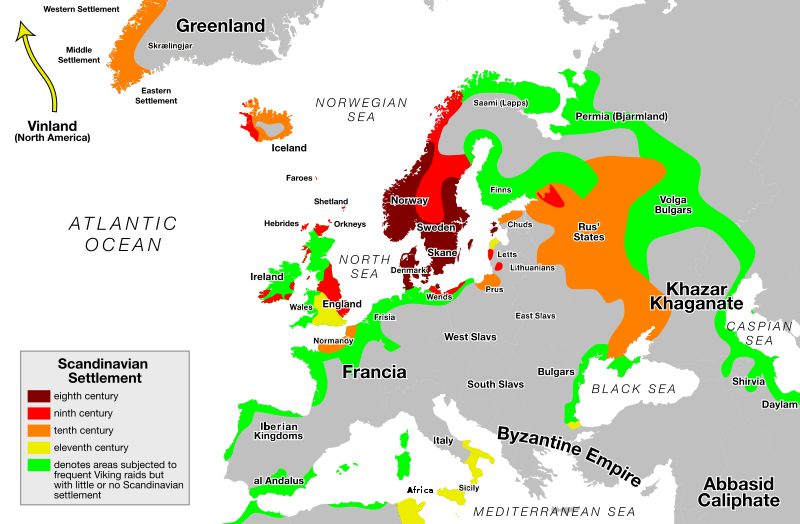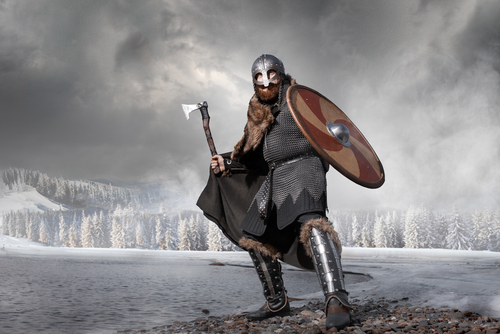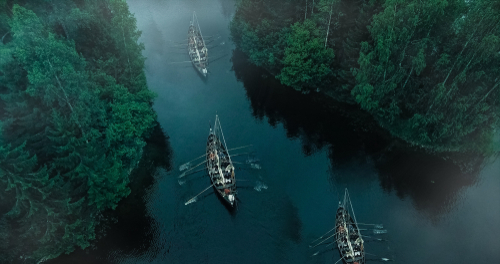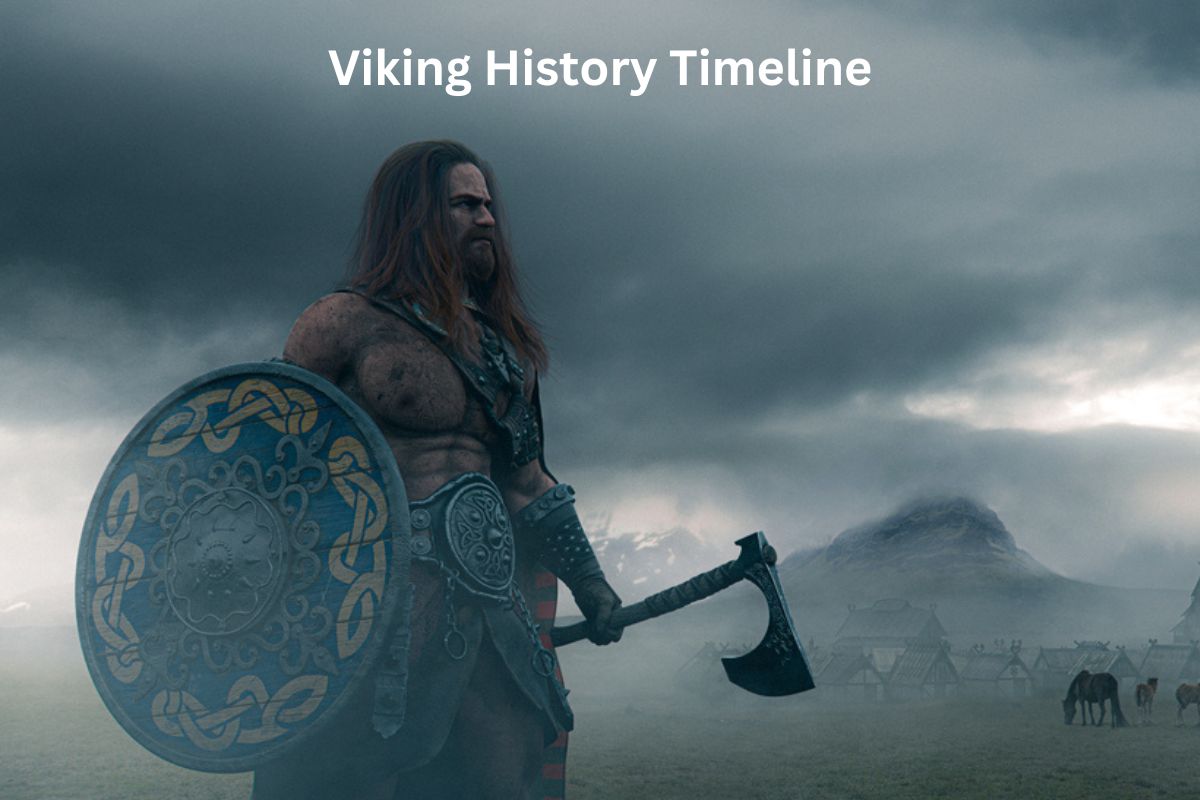The Viking Age, spanning roughly from the late 8th century to the early 11th century, was a pivotal period in European history characterized by the seafaring and warrior activities of the Vikings.
Originating from the Scandinavian regions of modern-day Norway, Sweden, and Denmark, the Vikings were known for their iconic longships, fierce raids, and extensive exploration of distant lands.
During this era, the Vikings left an indelible mark on the world through their daring expeditions, establishing settlements in various regions, and trading with far-off cultures.
They impacted the development of Europe, Asia, and even North America, while also contributing to the exchange of ideas and technology.
The Viking Age was marked by a complex interplay of conquest, trade, cultural assimilation, and eventual integration into the societies they encountered.
This dynamic and multifaceted history continues to captivate our imaginations and shed light on the rich tapestry of Viking civilization.
| Year | Event |
|---|---|
| 793 AD | Lindisfarne Raid |
| 800s AD | Viking Expansion |
| 840s AD | Viking Invasions of Ireland |
| 860s AD | Rus Vikings |
| 866 AD | Great Heathen Army |
| 911 AD | Norman Conquest of Normandy |
| 982 AD | Erik the Red in Greenland |
| 986 AD | Bjarni Herjólfsson’s North America Sighting |
| 1000 AD | Leif Erikson’s Vinland Exploration |
| 1013 AD | Viking Conquest of England |
| 1016 AD | Canute the Great’s North Sea Empire |
| 1066 AD | Battle of Stamford Bridge |
| 1066 AD | Norman Conquest of England |
Timeline of the Vikings
793 AD – Lindisfarne Raid
In 793 AD, Vikings from Norway launched a devastating raid on the Lindisfarne Monastery in the Kingdom of Northumbria, located on the northeast coast of England.
This event is often considered the beginning of the Viking Age in Western Europe. The Vikings, known for their swift longships and fierce warriors, plundered the monastery, killed or captured monks, and took valuable treasures.
Also Read: Vikings Facts
The Lindisfarne Raid sent shockwaves throughout Europe, as it was the first recorded Viking attack on a Christian religious institution.

800s AD – Viking Expansion
During the 800s AD, Vikings expanded their reach across Europe. They conducted raids, explored new territories, and established trading routes. Vikings targeted regions such as France, Ireland, Scotland, and England.
Also Read: Facts About Erik the Red
Their fast and versatile longships allowed them to navigate rivers and coastlines, enabling surprise attacks deep into the continent. Viking raids disrupted local communities, but they also facilitated cultural exchange and trade between the Norse and other European peoples.
840s AD – Viking Invasions of Ireland
In the 840s AD, Vikings began to settle in Ireland. They established fortified settlements known as “longphorts” along the coasts and navigable rivers. These settlements served as bases for Viking raids and trade expeditions.
Over time, Vikings integrated with the local population, and their influence can still be seen in Irish place names and archaeological discoveries. The Viking presence in Ireland had a lasting impact on the country’s history and culture.
860s AD – Rus Vikings
Vikings from Sweden and Denmark ventured eastward into what is now Russia and Ukraine during the 860s AD.
They established trade routes along rivers such as the Volga and Dnieper and established settlements, leading to the formation of the Kievan Rus. These Vikings, known as the Rus Vikings, played a crucial role in early Russian history.
Their trade connections with Constantinople (Byzantine Empire) enriched the region economically and culturally. The legacy of the Rus Vikings can still be observed in the historical development of Eastern Europe.

866 AD – Great Heathen Army
In 866 AD, a formidable Viking force known as the Great Heathen Army (also called the Great Viking Army) landed in England. Composed of warriors from Denmark and possibly other Scandinavian regions, this army sought to conquer and establish a foothold in England.
Led by leaders like Ivar the Boneless and Halfdan Ragnarsson, the Great Heathen Army engaged in a series of battles and campaigns, eventually capturing the Kingdom of Northumbria, East Anglia, and parts of Mercia.
911 AD – Norman Conquest of Normandy
In 911 AD, the Viking leader Rollo (also known as Hrolf the Walker) secured a significant portion of what is now northern France, including the region of Normandy, from the Frankish King Charles III (Charles the Simple).
Rollo agreed to convert to Christianity and swore allegiance to the Frankish crown in exchange for this land grant. This event marked the beginning of Norman rule in Normandy and laid the foundation for the eventual Norman Conquest of England in 1066.
982 AD – Erik the Red in Greenland
In 982 AD, Erik the Red, an Icelandic Viking exile, sailed westward and discovered a large, uninhabited landmass that he named Greenland. He hoped to attract settlers by giving it an appealing name, despite the fact that much of Greenland is covered in ice.
Erik established the first Norse settlements on the southwestern coast, and these colonies survived for several centuries.
The Greenland Vikings primarily engaged in farming and trade, and their interactions with the native Inuit peoples were both cooperative and conflictual.
986 AD – Bjarni Herjólfsson’s North America Sighting
In 986 AD, Bjarni Herjólfsson, a Norse explorer, is believed to have unintentionally sighted the North American continent while en route from Iceland to Greenland.
Though he did not make landfall, his sighting is significant because it predates the more deliberate exploration and settlement efforts in North America by other Vikings, particularly Leif Erikson’s voyage to Vinland around the year 1000.
1000 AD – Leif Erikson’s Vinland Exploration
In the year 1000 AD, Leif Erikson, the son of Erik the Red, led an expedition to the North American continent. He is believed to have established a settlement in an area he called Vinland, likely located in what is now Newfoundland, Canada.
This makes Leif Erikson one of the earliest known European explorers to reach the Americas, pre-dating Christopher Columbus by nearly five centuries. The settlement, however, was short-lived, possibly due to conflicts with indigenous peoples or limited resources.

1013 AD: Viking Conquest of England
In 1013 AD, Sweyn Forkbeard, a Viking king of Denmark, successfully conquered England. Sweyn’s forces, which included his son Canute (Cnut), defeated the English king, Æthelred the Unready.
Sweyn was briefly declared King of England before his death in 1014. His son, Canute, eventually consolidated Viking rule in England, establishing the North Sea Empire, which also included Denmark and parts of Norway.
1016 AD – Canute the Great’s North Sea Empire
In 1016 AD, Canute the Great, the son of Sweyn Forkbeard, achieved a significant Viking conquest by uniting England, Denmark, Norway, and parts of Sweden into a vast North Sea Empire.
His rule was marked by a degree of stability and consolidation, and he is known for his efforts to promote Christianity in his realm. The North Sea Empire represented a high point of Viking power and influence in Europe.
1066 AD – Battle of Stamford Bridge
In 1066 AD, King Harold II of England faced a Viking invasion led by King Harald Hardrada of Norway. The Battle of Stamford Bridge in Yorkshire, England, saw a decisive English victory, leading to the defeat and death of Harald Hardrada.
This battle was one of the last major Viking invasions in England and marked the beginning of a fateful chain of events in that year.
1066 AD – Norman Conquest of England
Later in 1066 AD, following the Battle of Stamford Bridge, King Harold II of England faced another invasion from the Normans, led by William the Conqueror (William I of England).
The Norman Conquest of England culminated in the famous Battle of Hastings on October 14, 1066, in which William defeated Harold II. This event led to the establishment of Norman rule in England and the subsequent Norman influence on English culture, language, and governance.
